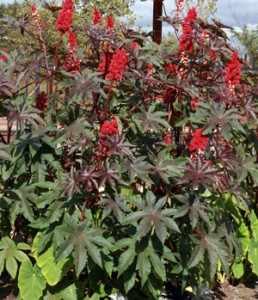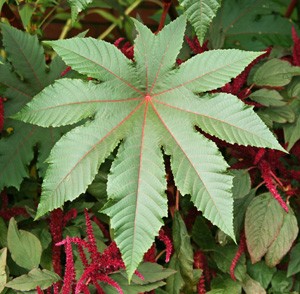General Information:
Ricinus communis, commonly known as the castor bean, is native to east Africa, particularly around Ethiopia, but will grow in most tropical/sub-tropical climates. It is an herbaceous, slightly woody, perennial that can grow as a shrub or tree, depending if it was grown as an annual or perennial. It prefers moist, well-drained and disturbed soil, such as along riversides. If allowed to grow long enough in the right environments, they can grow up to 40ft. tall as trees, producing and expanse of large star-shaped leaves. It gets its Latin name Ricinus, meaning “tick,” from the unique appearance of the seeds resembling a European tick.


Castor plants can grown annually as a large shrubs (first image), or perennially as a tree (second image).


These images show the significant stages of the development of the castor bean’s seeds. The first image exemplifies the tick-like appearance of the seeds.

Castor leaves can have large leaves with 5-11 palmate lobes and can grow over 2 1/2 ft. across. They can also have a wide variety of leaf colors depending on the plant: glossy green, black-purplish, dark red-metallic, bronze-green, maroon, or bright green with white veins.
Traditional Uses:
The Castor bean as a whole has no medicinal uses and has been used primarily as a warfare agent because of its ricin-induced toxicity, but Castor oil, extracted from the bean, historically has many medicinal uses. Castor oil is extracted from the seed separate from ricin, and has been used for 6000 years. Once in oil form, it has traditionally been used in two ways : ingesting it and applying it topically to the eyes and skin. When applied topically, castor oil has been used to prevent/alleviate eye irritations and for its skin healing/anti-irritant properties. When ingested, it has been used to aid with digestion and if enough is consumed it acts as a strong laxative. It has also been used industrially as both a fuel source and lubricant for machines. Today, castor oil is primarily used for its skin treating abilities and presence in beauty products. These effects are believed to come from the ricinoleic acid present in the castor oil that inhibit the growth of viruses, bacteria, yeasts, and molds.
Chemical Constituents:
Ricin, derived from Ricinus, is the main chemical of interest in castor beans. Ricin is one of the most toxic substances known to humans. When inhaled, ingested or injected, symptoms can vary from nausea, vomiting, diarrhea, wheezing, sore throat, and/or blisters in low doses. In high doses symptoms can be seizures, shock, organ failure, respiratory failure, wide-spread necrosis, and death. Due to its toxicity, ricin is effective at small doses with 5 micrograms being the minimum lethal dose. The primary mechanism of action for ricin toxicity is inhibition of protein synthesis, but also works by direct cell membrane damage, initiation of apoptosis, and release of cytokine inflammatory mediators.
Current Research:
Previous research on the castor bean has been primarily limited to its toxicity from ricin. This toxicity, in combination with its availability, make castor beans a concern for biological terrorism, so much research was devoted to it during war times. Currently, however, there is no war, so the research being conducted is more mundane. One of the research investigations being conducted is on how castor beans can be used industrially, mainly as feedstock. This research sought to look for new sources of biofuel from non-consumable plants. The researchers produced biodiesel from the beans, concluding the biodiesel from the castor beans met biofuel standards, even exceeding them in low temperature functionality.
Sources:
AL-Tamimi, Faisal A, and Ahmad E M Hegazi. “A Case of Castor Bean Poisoning.” Sultan Qaboos University Medical Journal 8.1 (2008): 83–87. Print.
Smith ME, Hayoun MA. Toxicity, Ricin. [Updated 2017 Jun 10]. In: StatPearls [Internet]. Treasure Island (FL): StatPearls Publishing; 2018 Jan-. Available from: https://www.ncbi.nlm.nih.gov/books/NBK441948/?report=classic
Mahr, Susan. “Castor Bean, Ricinus Communis.” Master Gardener Program, University of Wisconsin – Madison, wimastergardener.org/article/castor-bean-ricinus-communis/.
Silitonga, A S, et al. “Synthesis and Optimization of Hevea Brasiliensis and Ricinus Communis as Feedstock for Biodiesel Production: A Comparative Study.” Industrial Crops and Products, Elsevier, 19 Mar. 2016, http://www.sciencedirect.com/science/article/pii/S0926669016301637.
“Castor Oil: Historical Background, Success Stories, Internal & External Health Benefits.” Health for All Women, 9 Feb. 2017, healthforallwomen.com/castor-oil-series/.
Images: http://howtoword.com/fast-growing-shade-trees.html
This page was created by Jerry Willour
